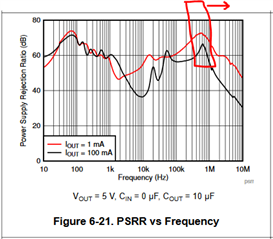Hi team,
How much does the output capacitance value affect the PSRR performance?
I would like to request a PSRR vs frequency plot for TPS7B8133-Q1 and TPS7A6633-Q1 just like Figure 6-22 in the datasheet of TPS7B8133-Q1.
My condition is Cin=1.0uF, Cout=2.2uF, Vout=3.3V, Iout = 10mA
while Figure 6-22 is Cin=0uF, Cout=10uF, Iout = 1mA or 100mA
I would like to know how much Cin/Cout value affect the PSRR performance.
regards,


